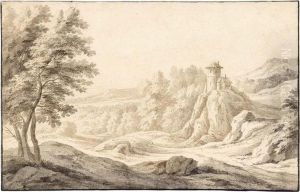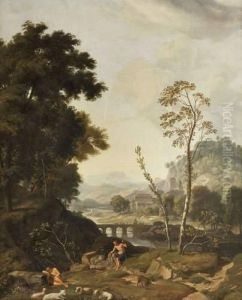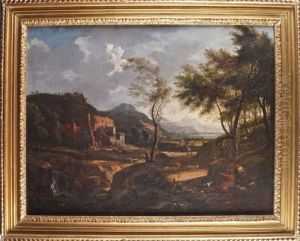Albert Meijeringh Paintings
Albert Meijeringh was a Dutch painter and engraver born in 1645, in the Netherlands, during a period known as the Dutch Golden Age. This era is celebrated for its remarkable achievements in the arts, sciences, trade, and the military. Meijeringh was part of this vibrant cultural milieu, contributing to the rich tapestry of Dutch artistic heritage through his landscape paintings and engravings. While detailed records of his early life and training are scarce, it is evident through his works that he was deeply influenced by the dominant artistic trends of his time, particularly the emphasis on realism and the meticulous depiction of natural and urban landscapes.
Meijeringh's oeuvre mainly consists of landscapes, including both rural scenes and cityscapes, which demonstrate his keen observation and ability to capture the serene beauty of the Dutch countryside as well as the bustling activity of its cities. His works are characterized by a delicate handling of light and shadow, a skill that adds depth and realism to his scenes. He was particularly adept at engraving, a technique that allowed him to achieve remarkable detail and precision in his depictions of architectural elements and natural scenery.
Throughout his career, Albert Meijeringh was active in Amsterdam, where he was part of the city's thriving artistic community. His works were well-received and collected by contemporaries, contributing to the visual documentation of the Dutch landscape and urban environment during the 17th century. Despite his accomplishments, Meijeringh is not as widely recognized today as some of his contemporaries, such as Rembrandt or Vermeer. Nonetheless, his paintings and engravings remain valuable to art historians and collectors for their quality and for the light they shed on the Dutch Golden Age's artistic landscape.
Albert Meijeringh continued to produce art until his death in 1714. His legacy, while modest in comparison to the era's leading figures, is preserved in various art collections and museums, offering insight into the lesser-known artists who contributed to the richness of Dutch art during one of its most flourishing periods. Meijeringh's work is a testament to the depth and diversity of talent that existed during the Dutch Golden Age, reminding us of the importance of recognizing and appreciating the contributions of artists beyond the most celebrated names.


